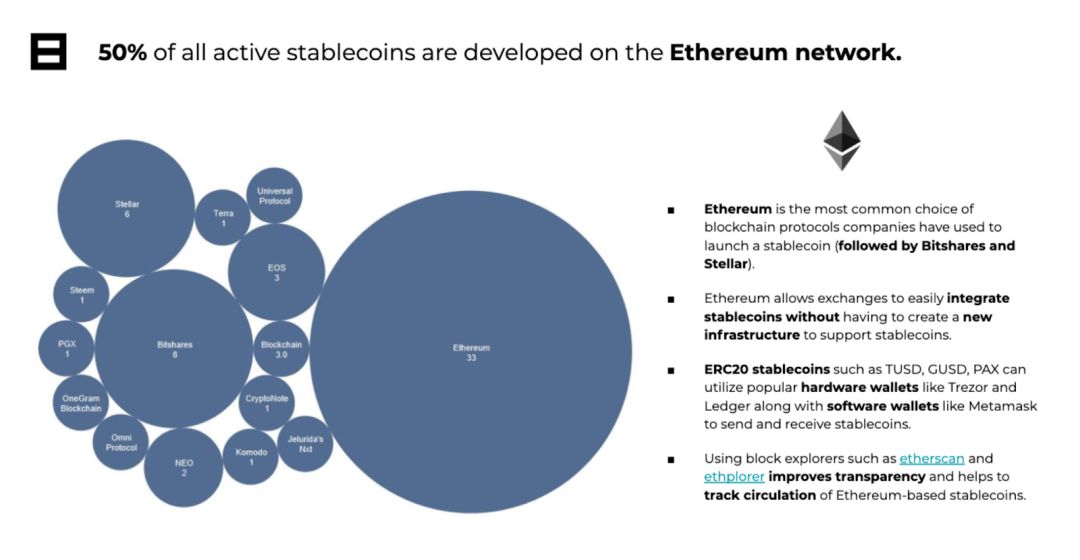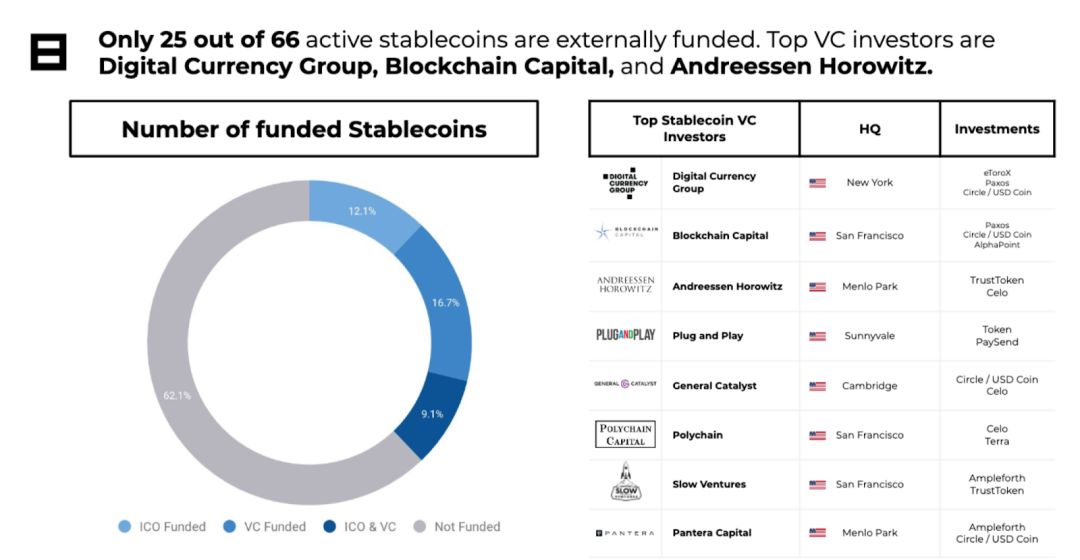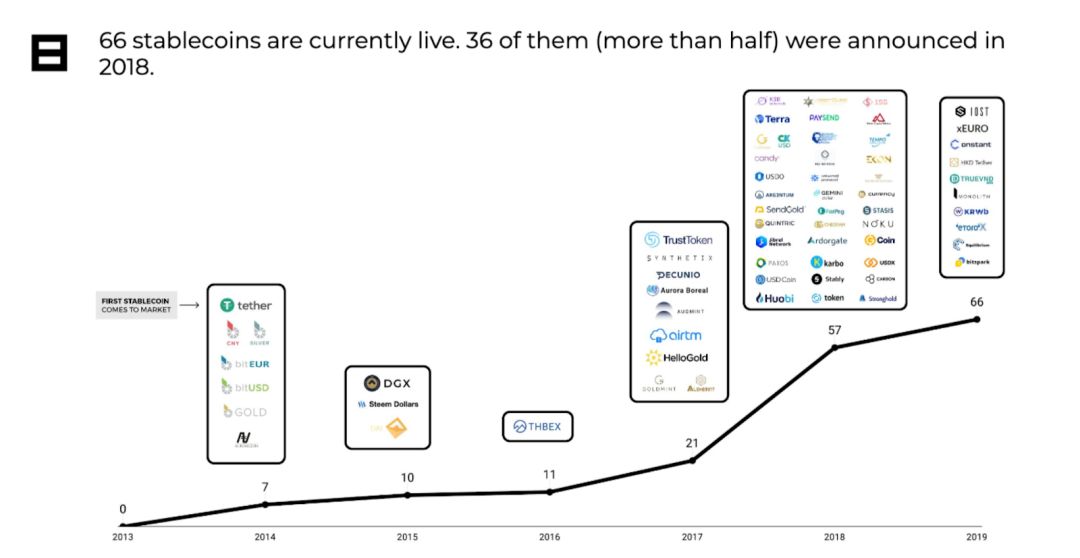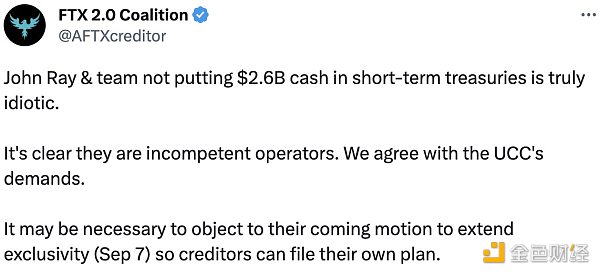ConsenSys latest report: 2019 Stabilization currency status

- First, since the beginning of 2017, more than 200 stable currency projects have been announced, but 30% of them have not yet been publicly launched;
- As of this writing, there are about 66 open and active circulation stabilization coins on the market. The report predicts that 2019/2020 may be the “big year” for stable currency.
- Of all the stable coins that have been launched, 50% of the active stable currency was developed on the Ethereum network.
- In addition, dollar-backed stable currencies such as Tether, Coinbase's USDCoin, and Gemini's Gemini Dollar are the most active.
- Those stable coins backed by gold are likely to fail.
- Of all the current stable currencies, Tether has accumulated the most funds, and they have raised more than $1 billion through IEO this year.
Getting started with stable coins
Let's start with some background on stable coins from the SensSys report "State of Stablecoins" by Nathan Sexer
A stable currency is a cryptographic asset that maintains a stable value linked to a target price (such as the US dollar) ; the stable currency is designed to serve those specific (decentralized) applications that require lower fluctuations in volatility An application that can run on a blockchain.
- Bitcoin Mining In-depth Survey: Chinese mining machine dealers dominate, mining in the first half of the year is called profiteering
- Video | Babbitt "8 Questions" 2 minutes mixed, 40 industry big brothers together with the box, inciting people!
- Bitcoin breaks through 10,000, and the bull market really depends on halving support?
The reason why cryptocurrency is difficult to be widely used as a value store is because of its volatility. They are not representative of a suitable trading instrument or account unit due to large price fluctuations. In fact, if the value of a digital currency may fall dramatically every other day, which business will be willing to accept it?
Large fluctuations also make it difficult to accept a currency as an “account unit” because the “value” of the currency and the “value” of the future cannot form a standard acceptable to everyone. By definition, a unit of measure should remain stable. Therefore, volatility transforms what is trying to become a cryptocurrency into a speculative crypto asset. If you can reduce volatility, encrypted assets can actually reach a wider audience.
There are many reasons for large fluctuations, such as:
- Changing public perception
- Emerging Markets
- Static monetary policy
- Unregulated market
scenes to be used
Application scenarios where volatility must be reduced include:
1. Remittance. In the payment process, the price difference can be covered;
2. Trade and payment. For any business that accepts daily payments, the currency or cryptocurrency should avoid large fluctuations;
3. Salary and rent. And other recurring payments;
4. Loans and forecasting markets (long-term issuance) ;
5. Trading and wealth management. In this case, the reason why you need to stabilize the coins is because they:
- Make it possible to name the transaction pair in US dollars instead of Bitcoin or Ethereum;
- Make risk exposures at French currency rates (instead of ETH or BTC) ;
- Just show its fluctuations in French currency, you can achieve visibility and adoption;
- It is possible to achieve arbitrage.
6, value storage, for long-term hedging: For example, miners can use the stable currency to cover recurring expenses to ensure a stable income.
In other words, anyone who wants to benefit from the advantages of blockchain technology (transparency, security, immutability…) but does not want to lose the guarantees (such as trust and stability) provided by the legal currency, Need some kind of stable cryptocurrency.
Various types of stable coins

The picture above is from " Stablecoins: designing a price-stable cryptocurrency " by Haseeb Qureshi .
Stabilized currency collateralized by legal currency
This is an "IOU" type of "centralized" stable currency, either supported by legal currency or a commodity as collateral. This category includes Tether , USD Coin , Gemini, and Digix .
Stabilized currency collateralized by cryptocurrency
This refers to the "decentralized" stable currency of the "under-strip" type, or supported by cryptocurrency support and /or multiple assets acting as collateral. This type of stable currency includes MakerDAO , Steem and Alchemint .
Unsecured Stabilized Coins are mechanisms that use Seigniorage Shares / Decentralized Banks/Utilization Algorithms to maintain stability. This type of stable currency includes Terra , Ampleforth and Element Zero.
The favorite blockchain network in the stable currency is undoubted, Ethereum is the favorite blockchain network of stable currency, 33 stable coins are developed on the basis of the Ethereum agreement; Bitshares ranked second, with 8 A stable currency is built on its blockchain; the Stellar block chain ranks third with six stable coins.
There are many reasons why Ethereum dominates: First, Ethereum benefits from its first-mover advantage. Early projects like MakerDAO chose to issue stable currency DAI on Ethereum . Second, Ethereum ’s stable currency benefited from Its powerful infrastructure and easy-to-use ERC-20 token standard.
For example, there are already many wallets, exchanges, and analysis tools (such as Alethio, Etherscan, MyCrypto, etc.) that are compatible with Ethereum . When the new stable currency tries to expand and grow rapidly, it is easier to implement on Ethereum than other blockchains. The enterprise version of Ethereum , such as Quorun used by JPMorgan Chase, has further made Ethereum the first choice for stable currency distribution.

Stabilizing currency financing IEO (Initial exchange offerings) showed an upward trend in 2019, becoming a new financing method for the cryptocurrency industry. It is worth noting that Tether raised more than $1 billion through IEO.
Despite Tether's skills in fundraising, other head-stabilized currency projects and companies have raised $500 million in the past two years, such as Coinbase's stable currency, USD Coin, through three rounds of financing, raising more than 2 funds. One hundred million U.S. dollars.

Wind investing in the home is very clear, once a stable currency is successful, it can produce very substantial profits. Top venture capital firms like Digital Currency Group , Blockchain Capital and Andreessen Horowitz have invested heavily in the cryptocurrency industry, especially the Stabilizationcoin program. In fact, nearly half of the active currency in the market has been supported by venture capital.
In the past two years, the number of stable currencies has grown rapidly. While groundbreaking stable currencies such as Tether, TrustToken and DAI still dominate market share, competition is rapidly approaching. Of course, not all stable currency projects can succeed, but the dramatic increase in the number of stable currencies over the past two years clearly shows that many people, entrepreneurs and companies agree that stable currencies will have a huge impact on the world.

The following is a non-exhaustive list of stable coins that are currently active or put into production on the market:
Affordable, centralized, collateral-backed stable currency
Supported by legal currency (or traditional assets) reserves
- USDCoin
Coinbase's stable currency anchored with the US dollar.
- Gemini Dollar
Stabilized currency linked to the US dollar by the Gemini Exchange.
- Tether
The dollar-backed stable token (USDT) is also the leader in the stable currency market.
- TrueUSD (by TrustToken)
The dollar-backed stable cryptocurrency (TUSD) focuses on transparency and is built on Ethereum .
- Digix Gold Tokens
Gold-stable tokens (DGX), 1DGX = 1 gram of gold in the Singapore vault.
- EURS (Stasis initiated)
EIP-20 stable currency collateralized in euro-backed French currency with verification flow mechanism, supported by STASIS.
- Globcoin.io
- PAX
- Monerium
- StrongholdUSD
- Jibrel (Jibrel Network)
- PHI (launched by dfinity-network)
- Saga
- PHP Bitspark
- GBT
- Libra
- Stably
- eToro Native Tokens
- THBEX
- Stronghold USD (launched by Stronghold and IBM)
- USD Coin (launched by Circle & CENTRE)
- X8currency
- Bitshares
- Havven.io
- MakerDAO
- StatiCoin
- Alchemint
- Augmint
- Boreal (launched by aurora-dao)
- Celo
- Reserve (launched by Reserve Research Team)
- Sweetbridge
- Unum
Neutral Dollar
Launched by the financial technology startup Neutral, Neutral Dollar is a safe, transparent, and volatility basket of stable coins produced by USDC, PAX, DAI and TUSD four stable coins through 100% full pledge of Ethereum Smart Contracts. Neutral completed the A round of financing led by Sequoia China last year. Co-founder and CEO Chen Guo was the founding partner of FBG Capital. The team co-founder also included former high-frequency trading company Virtu Financial technical expert Matthew Branton, former Susan venture capitalist Jason Zhang, former Lazard cross-border M&A banker Liu Yulong and other serial entrepreneurs and Wall Street traders.
USDx
The USDx is decentralized by a basket of US dollar stable coins through smart contracts, and is the first stable currency to realize the chain. The stable currency was launched by the decentralized financial and monetary agreement platform dForce. dForce was founded by Yang Mindao, founder of blockchain investment fund Blockpower Capital. The core members of the team are elites from top financial institutions such as Goldman Sachs, Standard Chartered, Citigroup, Hony and early participants in the digital currency industry.
- BitBay Official
- NuBits
- SteemDollar (launched by Steemit)
- Carbon
- Corion
- Fragments
- Kowala (launched by Kowala Tech)
- Topl
- Stable
- StableUnit
- TerraMoney
We will continue to update Blocking; if you have any questions or suggestions, please contact us!
Was this article helpful?
93 out of 132 found this helpful
Related articles
- R3 enters into strategic partnership with Dubai Financial Technology to build the next generation financial architecture for Islamic capital markets
- Blockchain security | APT attacks against a blockchain digital cryptocurrency trading platform
- The multiple contradictions are concentrated and the reasons for the low XRP currency price are down?
- 78% of the cottage currency hit a three-month low, is it worth investing?
- QKL123 market analysis | Bitcoin rapid downturn, the altcoin transaction against the new low (0829)
- Institutions sought after, Angel Wheel financing 20 million, what is the advantage of NewStar (net red chain) that changes the underlying accounting logic of the online red industry?
- Bitcoin is the first to adopt bitcoin, and GMO, the largest Internet company in Japan, pays more than 4,700 employees in bitcoin.






